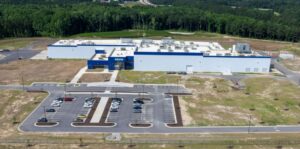Enhanced rock weathering is an old concept, but its entry into agriculture is relatively new.
“I think for biologicals in ag, the emphasis hasn’t been on rock weathering because there hasn’t been a recognition of the connection to carbon removal,” says Hans Holtan, who co-founded a startup recently addressing this. “It hasn’t been very long that we’ve had carbon credits and a substantial market that investors feel like pursuing.”
Sensing opportunity, Holtan started Syntopa in 2023 to develop microbial products that address major issues at the intersection of crops and climate change, starting with microbes that do enhanced rock weathering. The company raised a $575,000 pre-seed round from Ponderosa Ponderosa Ventures earlier this year.
Enhanced rock weathering is, in a nutshell, a carbon removal solution that involves accelerated weathering of rocks (oftentimes through crushing them) that can capture carbon. (See this overview of different types of rock weathering.) Syntopa aims to supply the biologics to be used in conjunction with enhanced rock weathering to accelerate the process.
“This is really our opportunity to start to de-risk the enhanced rock weathering concept from a technical and commercial point of view,” Holtan tells AgFunderNews. “We’ll pretty rapidly be moving towards additional funding to really scale up the research and development to get first products to market by 2027.”
Below, he discusses the basics of enhanced rock weathering, how it removes carbon, why the concept is important for fighting climate change, and why it’s (finally) starting to matter in agriculture.
AgFunderNews (AFN): You’ve been in ag your entire career. What led to start the company?
Hans Holtan (HH): I got my PhD in plant genetics from Berkeley, and worked at Mendel [Biotechnology] for many years helping to really expand their systems biology capabilities, and then managed a lot of the research there. I worked at Bayer and Koch to bring traits and chemistry for stress tolerance and other yield-protection traits to the farm, and that’s where I first got into biologicals for agriculture.
[Biologicals] obviously has a little bit of a checkered past and I got to experience that firsthand. I worked for several years at Koch Biologics to bring nutrient use efficiency for biologicals to market and got to see what’s out there. I tested a lot of products that others had and then we [Koch] developed our own and successfully got them all the way through to market.
But in the end, even though our products worked and our platform was successful, it was a tough sell for the sales team, which was really used to selling commodity goods.
So I decided I really need to double down on what biology can do in order to make products that really kick butt in agriculture and can deal with the complexity that’s out there. I got a really high-speed education at Zymergen [biotech company acquired by Ginkgo Bioworks in 2022], where I worked for several years, straddling the business development and technical teams. I got to see, again and again, the power of synthetic biology today and how much we can make microbes better at what they already do.
When Zymergen got bought by Gingko, I decided to start Syntopa and brought some of that talent with me. We really landed on a tremendous opportunity to leverage some of those advanced methodologies that we were exposed to and bring products to market that don’t exist yet that the world needs.

AFN: Give us a crash course in enhanced rock weathering.
HH: Earth has a natural cycle of inorganic carbon — natural sources of CO2 in the atmosphere, and that CO2 is removed and cycled into other forms naturally as part of the chemistry and ecology of Earth.
One of the things that happens is the reaction of carbonic acid, which is what you get when you dissolve CO2 into water with igneous types of rocks, specifically what we call mafic rock, which is a volcanic rock. This is one of the primary types of rock that we have on earth: a lot of mountains are made out of it, Hawaii is made out of it a bit.
[This type] sequesters over a gigaton of CO2 naturally every year.
Enhanced rock weathering is when we leverage this mechanism to remove carbon dioxide from the environment intentionally. The easiest way to speed up that process is to increase the surface area of the rock. So instead of the rock being shaped like a mountain, we grind it into dust somewhere that it can react with carbonic acid, then you get carbon removal.
This is not contentious. Earth scientists have known about enhanced rock weathering for a very long time, and our climate models are based on this natural part of the cycle. It’s baked into the calculations we have for calculating the rate of climate change.
The ability to increase this process substantially by reducing the particle size [of the rock] is also very sound, clear science.
AFN: Where does it get complicated and/or challenging?
HH: Take an abundant source of rock like basalt, which is the most common mafic rock type out there. It doesn’t have a lot of heavy metals usually, so it’s safe and good to use as opposed to some of the faster weathering rocks that might be full of heavy metals that would be a burden on our agricultural lands, or wherever they’re put.
Unfortunately in practice, it takes 10 to 20 years for this rock to weather in the ground after application.
We have targets through international agreements like the Paris Agreement, and we’re going to start to move towards 10-plus gigatons of carbon removal as part of the plan to mitigate the worst effects of climate change.
If the process [of enhanced rock weathering] is so slow, and the amount of money that can be made through it is so limited companies struggle to scale, the impact on the farm is limited. You’re not able to do beneficial things like completely displace the use of liming, which farmers pay a bundle for regularly in most agricultural lands.
In many places around the country and around the world, the silicate that comes along with the basalt also improves agriculture. So all our grass-based crops really benefit from silicate: soy, corn, rice, wheat, etc. And that science is starting to become really clear too.
So if only [rock weathering could] happen fast enough and consistently enough that farmers could count on that and recognize that value, then there would be real potential to scale this as quickly as we need to actually make an impact in the world on climate change.

AFN: Why are you such a proponent of enhanced rock weathering?
HH: [I spent] many, many years bringing microbials to the farm, to applications and soil where I’ve seen the complexity of the relationship between crop soil chemistry and microbiology of microbiome. I know that this is going to take a lot of intentionality and that there’s huge potential for making sure that enhanced rock weathering works as well as it can on farms, if it’s applied coherently with a biological treatment.
Syntopa is not the first to this idea either; there there are decades of sporadic investigation into the impact of microbes on the speed of rock weathering, and so I feel like that science is clearly substantiated. Sometimes I see reports of up to 60-fold faster rock weathering in the lab through the application of microbes. So we know the potential is huge. The problem is really solving that complex interrelationship between different cell types, different crop types, and different existing microbiomes.
AFN: What sets Syntopa apart?
HH: We really do feel like going to the farm at the same time that enhanced rock weathering, crushed rock products are being developed is a huge potential opportunity for us because that allows us to bring in a microbe that’s well suited to be on that rock and establish sort of a first mover advantage.
People who study invasiveness of species recognize that incumbents have a defensive advantage. Microbes that get established in a particular place have an easier time staying there than bringing in someone to a new place and having them win a foothold there.
That’s flipping the script on traditional biologics where you’re always the invader of the native soil. We’re going on that native soil, which is probably not rich in basalt, so we can have the ideal strains there, get that foothold, and make sure that the mechanisms that those microbes bring are the ones that actually increase the amount of carbon removal, as opposed to increasing carbon leakage.
AFN: What is carbon leakage?
HH: If you break down the rock through mechanisms that are independent of carbonic acid, you basically get a loss of your potential carbon removal. It’s really important that you bring the right mechanisms, in part to speed up the process and in part to reduce the leakage you would get if you just left it up to chance to whichever microbes happened to be able to get onto that product.

AFN: Why haven’t we seen many startups focused on enhanced rock weathering previously?
HH: I think rock weathering per se has been more of an ecological interest in the academic fields. There’s been some research into processes related to mining — improving recovery of metals from spent mining tailings.
I think for biologicals in ag, the emphasis hasn’t been on rock weathering because there hasn’t been a recognition of the connection to carbon removal. It hasn’t been very long that we’ve had carbon credits and a substantial market that investors feel like pursuing.
Similarly, the importance of silica in crops and disease tolerance, drought tolerance and yield is relatively new. So [progress] is really a trifecta of investment, environment and recognition of the importance of silica and the ability to have these these things coming together at the same time that makes it commercially viable to bring rock to the farm.
AFN: Where is Syntopa at in terms of growth?
HH: We were able to put together a plan and leverage some of our intellectual property for how to go about this process, and to test effectively in commercial-scale research these different mechanisms.
We developed a strategy for engineering and reached out to venture capitalists to get started. We were able to close a round in February and moved into this lab and started executing on the plan to really prove out the different aspects of our pipeline, which is everything from bio-prospecting to collecting soils from different farms around the country, in different environments that are rich or poor in basalt.
We are also examining other mafic rocks. We’re identifying strains and starting to put them through a gauntlet of different tests that help us quantify not only efficacy for the mechanisms that we want, but also fitness and robustness. That helps us start to predict which ones are going to be a good match for a particular location or farming practice.
AFN: What channels will you work with?
HH: We’re looking both at novel channels, which can be something like selling directly, as well as the traditional ag channel with major seed companies and traditional partners for ag input.
We know there’s interest, but [we must] determine what sort of leverage we would have and what kind of picture we can see for going to market through those channels.




